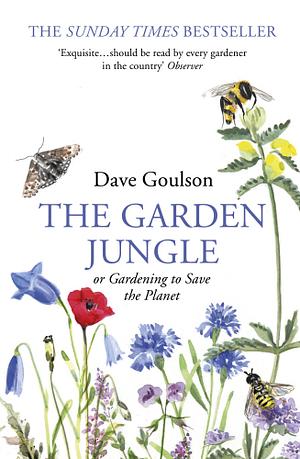
The Garden Jungle
by Dave Goulson
Genres: Non-fiction, SciencePages: 288
Rating:

Synopsis:The Garden Jungle is about the wildlife that lives right under our noses, in our gardens and parks, between the gaps in the pavement, and in the soil beneath our feet. Wherever you are right now, the chances are that there are worms, woodlice, centipedes, flies, silverfish, wasps, beetles, mice, shrews and much, much more, quietly living within just a few paces of you.
Dave Goulson gives us an insight into the fascinating and sometimes weird lives of these creatures, taking us burrowing into the compost heap, digging under the lawn and diving into the garden pond. He explains how our lives and ultimately the fate of humankind are inextricably intertwined with that of earwigs, bees, lacewings and hoverflies, unappreciated heroes of the natural world.
The Garden Jungle is at times an immensely serious book, exploring the environmental harm inadvertently done by gardeners who buy intensively reared plants in disposable plastic pots, sprayed with pesticides and grown in peat cut from the ground. Goulson argues that gardens could become places where we can reconnect with nature and rediscover where food comes from.
For anyone who has a garden, and cares about our planet, this book is essential reading.
The Garden Jungle is Dave Goulson’s paean to the richness and diversity we can create within our own gardens. Some of what he describes feels beyond out of touch — I have no idea if he realises how unlikely it is for other people to own enough land for a whole orchard, but you couldn’t tell from reading it — but his enthusiasm is genuine. He’s mostly interested in the insects, to be honest, with only brief mentions of other wildlife (like hedgehogs) that can thrive in our “garden jungles”. I’m pretty certain one thing our own tiny wildflower meadow is doing is providing shelter to the local hedgehogs as they forage, and that’s great.
It’s a fun read, and some of his footnotes made me smile. I was a bit less enraptured than I was by his book about bees, to be honest; I couldn’t say what would’ve made it better, but perhaps a little more attention to continuity between chapters. It’s a bit funny to read him in one chapter telling you that garden centres are selling plants laden with pesticides that will kill the insects in your garden, and in the next suggesting that you can go to buy plants at a garden centre and just look at the ones the insects land on… I’m certain that both are good suggestions in their way, but, hmmm.
I was interested by his stance on non-native plants. I personally feel that in some cases we’d be merely closing the barn door, and also that if we want anything to grow and thrive at all, we may need to bend with the conditions. The way humans ferry seeds about has been a part of how nature works for a very long time — it’s hard to draw a line now and say “this plant is a native, even though it was brought to the UK by the Romans” and “this plant is non-native, because Victorians brought it”. In the end, we need to focus on what thrives, and nurture as much biodiversity as we can — wherever it will grow. Goulson is rightly cautious about that, but not as preachy as some can be, accepting that some non-natives fill a valuable niche here.
Rating: 3/5

This sounds fascinating, but also sobering. Is the book aimed more at European or North American readers, do you think? I am very much not a gardener, so I have been wondering what we could do with native wildflowers and bushes that would be helpful to wildlife but require little upkeep, and wondering whether such a garden would be tidy enough not to fall afoul of my homeowners association’s rules.
Lark @ The Bookwyrm’s Hoard recently posted…Sunday Post – 7/07/2024